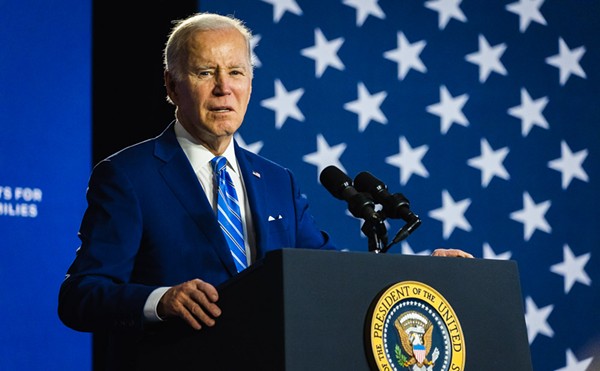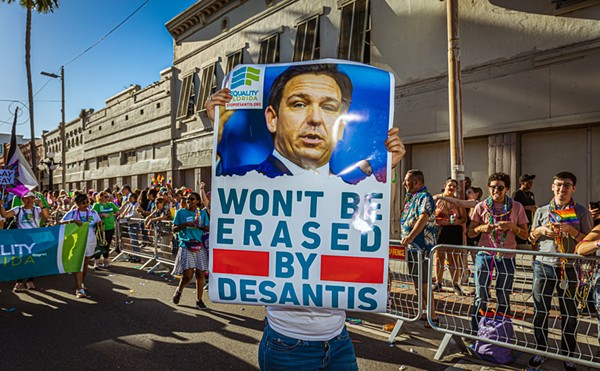The deaths of three policemen within the course of a month's time earlier this year rocked the citizens of St. Petersburg — none more so than the families of the officers, the SPPD and Mayor Bill Foster.
The murders and their aftermath also proved to be a turning point for Goliath "Go" Davis, for many years one of the area's most visible African-American leaders. A city administrator at the time and St. Petersburg's police chief from 1997-2001, he attended the wakes of all three officers — he would never not pay his respects, he says — but says he preferred not to undergo the searing experience of police line-of-duty funerals, and in fact hadn't appeared at one since 1980, when he was the pallbearer for his best friend, Herb Sullivan. In explaining to his immediate supervisor, city administrator Tish Elston, why he would not be attending the funerals of Officers Jeffrey Yaslowitz and Thomas Baitinger, he says he told her that "the bagpipes, the flyover, the pomp and circumstances" was all too much for him to process.
But as most people who live in Tampa Bay know by now, those funerals led to Davis' downfall. By not appearing at the official ceremonies for the slain officers, but attending the funeral of Hydra Lacy, Jr. — the man who shot and killed Yaslowitz and Baitinger in a gun battle — Davis suffered a backlash that ultimately ended his 37-year career with the government of his hometown. On March 2, his 60th birthday, he was informed by Mayor Foster that it was all over.
Davis explained the circumstances that led to his ouster at a news conference two days later. The fact that one of the speakers at the presser was Omali Yeshitela from the International Democratic Uhuru Party led popular radio rabble-rouser Bubba the Love Sponge to denounce him as "playing the race card."
Whether he has played it, or it's been played against him, race has always, inevitably, surfaced as an issue for Davis, an African-American pioneer in a historically segregated city. As Studio@620 co-founder Bob Devin Jones says, "This community has a very particular past, and unless and until we talk about that, way before Go Davis, then it will be the same as it ever was."
On a recent Tuesday morning, Go Davis sits across from me at a Bob Evans restaurant off of 34th Street S. in St. Petersburg, and orders a cup of hot tea. We've already had three phone conversations in which he questioned my intentions in doing this story, but now he seems relaxed and ready to engage.
Davis says that when he graduated from Rollins College in 1973, he knew he wanted to be involved in something socially active ("that was the era I was born into"). But being a police officer in his hometown was not on the list of options he was considering until a family friend challenged him to try to make a difference. He ended up staying with the SPPD for 28 years, the last four as chief.
Mayor David Fischer asked him to replace Darrel Stephens as police chief in the wake of the 1996 race riots in the predominantly African-American area of South St. Petersburg known as Midtown. During Davis' tenure, the department was subject to approximately a dozen lawsuits filed by former officers and police unions, accusing Davis of unfair and inconsistent discipline and playing favorites.
But one man who was always in his corner was the soon-to-be mayor, Rick Baker. In his just published book, The Seamless City, Baker writes that when he took over as mayor of St. Petersburg a decade ago, much of Midtown had "literally been torn apart." Describing the area as filled with blight and crime and lacking in basic services, he decided to make its redevelopment one of his four platform goals. And if he was going to succeed in that goal, he believed that the then-outgoing police chief was the "only person" who could make the effort succeed, and named him deputy mayor for Midtown economic development. In the book, Baker touts Davis' Ph.D in criminology: "Go understood the answer to crime and public safety is not just arresting people... perhaps we could head off some of our youth from going off in that direction."
Baker writes that he had to work hard to persuade Davis to buy into his vision for Midtown. But once he did, some notable progress was made — most substantively Tangerine Plaza, a 46,000-square-foot shopping center at 18th Avenue S. and 22nd Street anchored by a SweetBay Supermarket, as well as such crucial amenities nearby as a post office and a credit union. In addition to getting thousands of people signed up for checking and savings accounts, the credit union also provides financial training, which, according to City Councilman Karl Nurse, "really changes people's lives."















